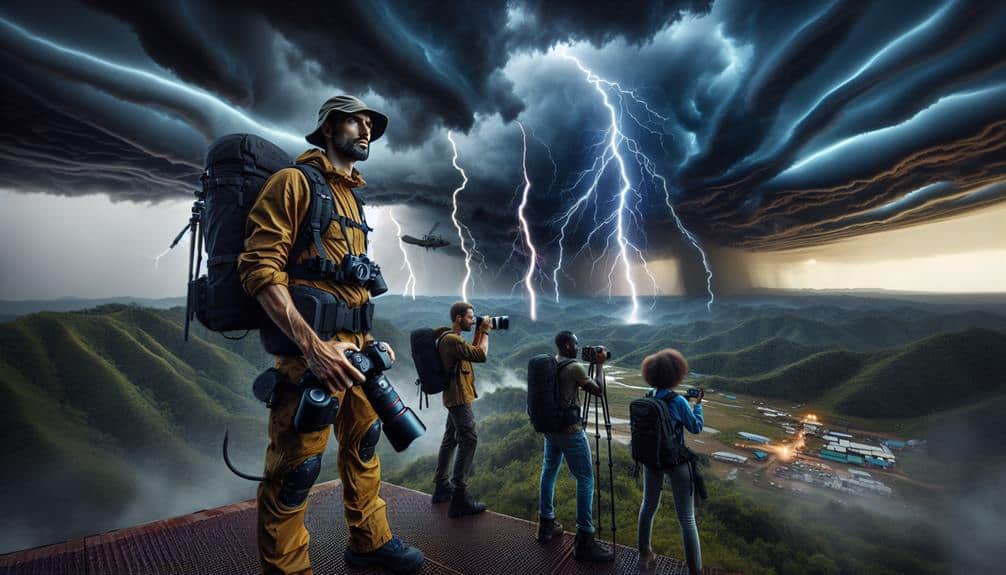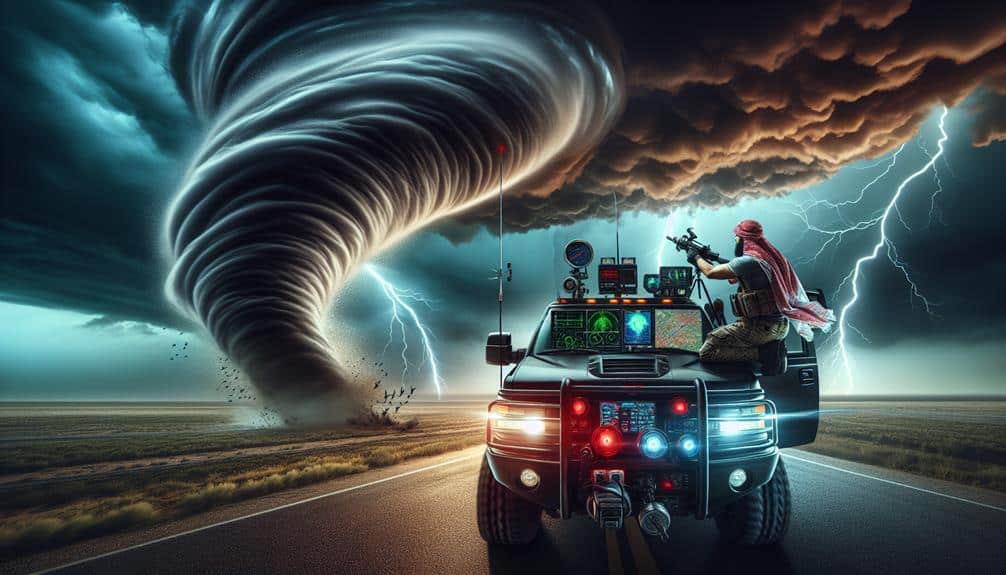Incorporating behavioral psychology into storm chasing can greatly improve safety. By understanding our risk perception and cognitive biases, we can make better decisions under pressure and manage stress effectively. Training for psychological resilience and utilizing emotional regulation strategies like deep breathing and cognitive restructuring can help maintain composure in high-stress environments. Effective communication within teams and strong leadership are essential for cohesive decision-making. Additionally, using real-time data and predictive models bolsters situational awareness. Exploring these psychological techniques can transform how we approach storm chasing, making it safer and more effective.
Key Points
- Implement cognitive restructuring techniques to mitigate cognitive biases and enhance risk assessment accuracy.
- Enhance team communication and trust-building to improve collective decision-making and situational awareness.
- Train for psychological resilience and stress management through scenario-based exercises and coping strategies.
- Utilize real-time data and predictive models for informed, data-driven decision-making under high-stress conditions.
Understanding Risk Perception
In order to enhance storm chasing safety, we must first analyze how individuals perceive and assess risks in high-stress environments. Our ability to effectively manage risk hinges on understanding the cognitive processes involved in risk assessment.
Research indicates that when faced with extreme weather, our brains can either overestimate or underestimate the danger due to cognitive biases and emotional responses.
We need to break down these biases methodically. For instance, confirmation bias may lead us to seek information that supports our desire to chase the storm, while ignoring signs that suggest retreat. Additionally, the thrill and adrenaline rush can cloud our judgment, making safety measures seem less urgent.
By recognizing these tendencies, we can develop more robust safety protocols. Training programs should incorporate simulations that mirror high-stress scenarios, allowing us to practice accurate risk assessment in a controlled environment.
Moreover, incorporating real-time data and predictive models can aid in making more informed decisions.
Ultimately, understanding risk perception isn't just about minimizing danger; it's about empowering us to make informed decisions while pursuing our passion. Through methodical analysis and evidence-based strategies, we can enhance our safety without compromising the freedom we cherish.
Decision-Making Under Pressure
Recognizing cognitive biases in risk perception sets the stage for analyzing how we make decisions under pressure during storm chasing. When we're in the thick of a storm, quick thinking is essential for our safety. The heightened stress of these situations can cloud our judgment, so understanding our decision-making process is essential.
Stress management techniques help us maintain a clear head. By recognizing stress symptoms early, we can employ methods to stay calm and focused.
Let's explore three key factors that influence our decision-making under pressure:
- Cognitive Load: High-stress situations can overwhelm our cognitive capacities, leading to rushed or poor decisions.
- Experience and Training: Seasoned chasers with rigorous training often perform better under pressure, as their responses become almost instinctual.
Our freedom to chase storms safely hinges on our ability to manage stress and think quickly. By being methodical and evidence-based in our approach, we can improve our decision-making under pressure, ensuring both our safety and the success of our storm chasing endeavors.
Emotional Regulation Strategies
Mastering emotional regulation strategies is vital for maintaining composure and making sound decisions during the high-stress environment of storm chasing. First, we need to prioritize self-care techniques to secure our mental and physical well-being. Regular exercise, sufficient rest, and balanced nutrition are foundational elements. By maintaining a healthy lifestyle, we strengthen our resilience to stress, enabling us to stay focused when stakes are high.
Second, let's incorporate practical stress management methods. Deep breathing exercises can help us quickly regain composure. Techniques like the 4-7-8 method, where we inhale for four seconds, hold for seven, and exhale for eight, can be particularly effective. Additionally, mindfulness practices, such as progressive muscle relaxation or guided imagery, can reduce anxiety and enhance our awareness of the present moment.
We should also acknowledge the power of cognitive restructuring. By reappraising our thoughts and challenging negative assumptions, we can shift our mindset from panic to problem-solving. This cognitive flexibility is essential in dynamic storm chasing scenarios where adaptive thinking can be the difference between safety and peril.
Group Dynamics in Storm Chasing
As storm chasers, our safety hinges on effective group dynamics, particularly in high-pressure situations. We need to analyze how decision-making under pressure, leadership roles, and conflict resolution strategies impact our team's performance.
Decision-Making Under Pressure
During high-stress storm-chasing scenarios, our decision-making processes are greatly influenced by group dynamics and peer interactions. When faced with the immediate threats of severe weather, stress management and quick thinking become vital. Our collective behavior can markedly impact the outcome of these high-pressure situations.
In storm chasing, the interplay between stress and decision-making is amplified by the group context. Each individual's actions can create a ripple effect, either stabilizing or destabilizing the team. Here are some key factors at play:
- Peer Influence: The decisions we make can be heavily swayed by our peers' opinions and actions, sometimes overriding our own better judgment.
- Shared Stress: High stress levels within the group can lead to a collective sense of urgency, which might foster quick thinking but also risk-taking behavior.
Understanding these dynamics lets us implement strategies to mitigate risks. We can use behavioral psychology principles to foster environments where stress is managed, and quick thinking is optimized. This approach not only enhances safety but also empowers us to make autonomous, informed decisions in the heat of the moment.
Leadership and Team Roles
Effective leadership and clearly defined team roles are paramount in ensuring safety and coordination during storm-chasing missions. Research in behavioral psychology reveals that team cohesion and communication greatly impact our ability to make quick, informed decisions in high-stakes environments.
When every team member knows their role, we reduce ambiguity, ensuring that everyone can focus on their specific tasks. Role clarity is vital for effective coordination. For instance, a designated navigator can relay real-time updates about the storm's path, while another team member focuses on data collection. This division of labor minimizes confusion and maximizes efficiency.
Studies have shown that teams with clearly defined roles outperform those with ambiguous role assignments, especially in dynamic and unpredictable situations like storm chasing. Moreover, strong leadership is essential for maintaining team cohesion. A competent leader not only assigns roles but also fosters an environment where open communication is encouraged.
When we trust our leader and feel comfortable voicing concerns, we can adapt more swiftly to changing conditions. Evidence suggests that teams with high levels of trust and effective communication are better equipped to handle the pressures of storm chasing, enhancing both safety and mission success.
Conflict Resolution Strategies
Managing conflict resolution in storm-chasing teams demands a systematic approach grounded in behavioral psychology principles. When we're in the field, tensions can run high, and conflicts may arise. To guarantee safety and cohesion, we need well-defined communication strategies and effective de-escalation techniques.
Effective conflict resolution hinges on three core elements:
- Open Communication: Encouraging team members to voice concerns and listen actively.
- De-Escalation Techniques: Using calm, clear language to defuse potential conflicts before they escalate.
Open communication is vital; it ensures everyone's on the same page, reducing misunderstandings.
We can use de-escalation techniques to manage heated moments, like taking a step back and using neutral, non-threatening language. These actions help to lower the emotional temperature and bring rationality back into the conversation.
Mediation skills and negotiation tactics are also essential. As a team, we should aim to understand both sides of any conflict and work towards compromises that satisfy everyone involved.
Cognitive Biases in Risk Assessment

Understanding cognitive biases is crucial for accurately evaluating risks associated with storm chasing. When out in the field, risk perception can be skewed by these biases, impacting decision-making and risk tolerance.
One common bias is the optimism bias, where the likelihood of encountering severe danger is underestimated due to a belief in positive outcomes. This can lead to taking greater risks than deemed acceptable.
The availability heuristic is another critical bias, leading to an assessment of event likelihood based on easily recalled examples. Exposure to dramatic footage of successful chases may inflate perceptions of safety and success, overlooking real dangers.
Confirmation bias also influences decision-making, as individuals tend to focus on information supporting desired outcomes while ignoring contradictory evidence. This bias can hinder making balanced, informed decisions in challenging situations.
Training for Psychological Resilience
To improve our safety and performance in storm chasing, we need to systematically train for psychological resilience. Research shows that psychological resilience enhances our ability to cope with stress and adapt to unexpected situations. Applying this knowledge to storm chasing, we can focus on several key areas to fortify our mental toughness and effectiveness.
- Stress Management: By engaging in regular stress management exercises like mindfulness and deep breathing, we can mitigate the anxiety that often accompanies high-stakes environments. These techniques help maintain clarity and focus, essential for making quick decisions.
- Scenario Training: We can simulate high-stress scenarios to build familiarity and reduce the shock of real-life events. This method leverages experiential learning to engrain effective responses to unpredictable storm behavior.
Frequently Asked Questions
How Can Technology Improve Safety Measures for Storm Chasers?
We can improve storm chaser safety through drone surveillance and GPS tracking. Drones provide real-time data on storm conditions, while GPS guarantees everyone's locations, enhancing coordination and response times in critical situations.
What Are the Legal Regulations for Storm Chasing Activities?
We need to understand the legal restrictions for storm chasing, which vary by region. Adhering to safety guidelines guarantees our freedom to chase while minimizing risks. Analyzing local laws and guidelines systematically helps maintain our safety and liberty.
Are There Specific Qualifications Required to Become a Storm Chaser?
We need educational requirements and field experience to become storm chasers. A background in meteorology or environmental science is essential, while hands-on practice with forecasting and safety protocols guarantees we're prepared for unpredictable weather.
How Do Weather Forecasting Advancements Impact Storm Chasing Safety?
Weather forecasting advancements enhance our risk assessment and decision making, allowing us to better predict storm paths and intensity. This reduces uncertainty, enabling safer storm chasing while maintaining our freedom to explore these natural phenomena.
What Are the Insurance Options Available for Storm Chasers?
We need to assess insurance coverage and risk management options for storm chasers. These options include specialized policies for equipment and liability, ensuring we can pursue our passion while minimizing financial risks and maximizing our freedom.


